My quest for the perfect pizza sauce led me to Naples, where I had the privilege of speaking with some of the city’s best pizzaioli. Their revelation was both simple and astounding.
Contrary to popular belief, authentic Neapolitan pizza sauce isn’t about a complex blend of herbs or hours of simmering. It’s about embracing simplicity and quality ingredients.
To make authentic Neapolitan sauce, all you need are high-quality tomatoes and fine sea salt. The process is surprisingly easy, and you can make the best pizza sauce in your life in under 5 minutes!
The keys to amazing Neapolitan pizza sauce are:
- Using high-quality tomatoes, preferably San Marzano
- Hand-crushing the tomatoes for the best flavor and texture
- Only add salt, and don’t cook the sauce to let the bright, and fresh tomato flavor shine
Authentic Neapolitan pizza sauce recipe
Ingredients
- 400 g (one 14oz can) skinless, tomatoes (preferably San Marzano)
- 4 g (3/4 tsp) fine sea salt
Instructions
- Open the canned tomatoes and add them to a mixing bowl.400 g (one 14oz can) skinless, tomatoes
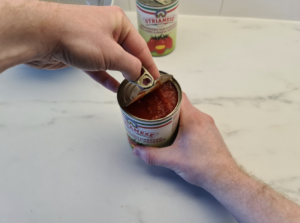
- Add the salt.4 g (3/4 tsp) fine sea salt
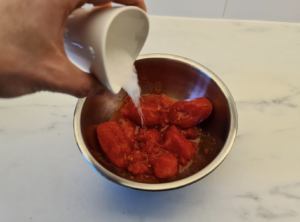
- Crush the tomatoes using your hands.
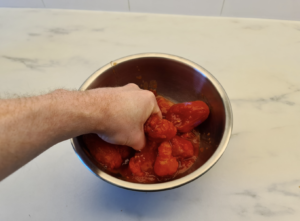
- The sauce is ready when you have a nice, spreadable sauce. It should be on the thin side, but still a bit chunky.
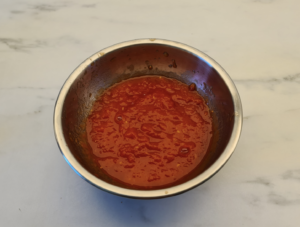
What’s so special about Neapolitan pizza sauce?
What truly sets Neapolitan pizza sauce apart is its simplicity. It’s a celebration of the sweet, fresh tomato flavor that perfectly balances with the other traditional ingredients of a Neapolitan pizza.
At its core, true Neapolitan pizza sauce consists of just two ingredients:
- tomatoes
- fine sea salt
Unlike most other pizza sauces, Neapolitan sauce is not cooked. Instead, it’s hand-crushed and added raw to the pizza, allowing the vibrant flavor of the fresh tomatoes to shine through.
The quality and flavor of the tomato are therefore crucial. The pinnacle of Neapolitan pizza is the San Marzano tomato. Naples is renowned for its exceptional tomatoes. and the volcanic soil around Mount Vesuvius produces some of the sweetest and most flavourful tomatoes in the world.
What authentic Neapolitan pizza sauce tastes like
Neapolitan pizza sauce is a celebration of the tomato flavor, and it should be a balance between sweetness and acidity, with a hint of salt to enhance the natural flavors of the tomato.
I remember my first trip to Naples, and how surprised I was by the exceptional taste of the sauce. The intense fresh tomato flavor was unlike anything I had previously experienced in a pizza. It was slightly salty, which created a perfect harmony with the creamy mozzarella and the distinctively charred crust. This experience not only made me appreciate the sauce and its importance in Neapolitan pizza but also always look for the very best tomatoes I can find.
Getting the consistency right
Achieving the right consistency is crucial.
Neapolitan pizza sauce should be thin and chunky. Traditionally, you hand-crush the tomatoes; this preserves some of the texture. It should feel like you’re actually eating tomatoes. So, you don’t want to blend the sauce, since this will affect both the texture and the consistency.
Below is a picture of the right consistency:
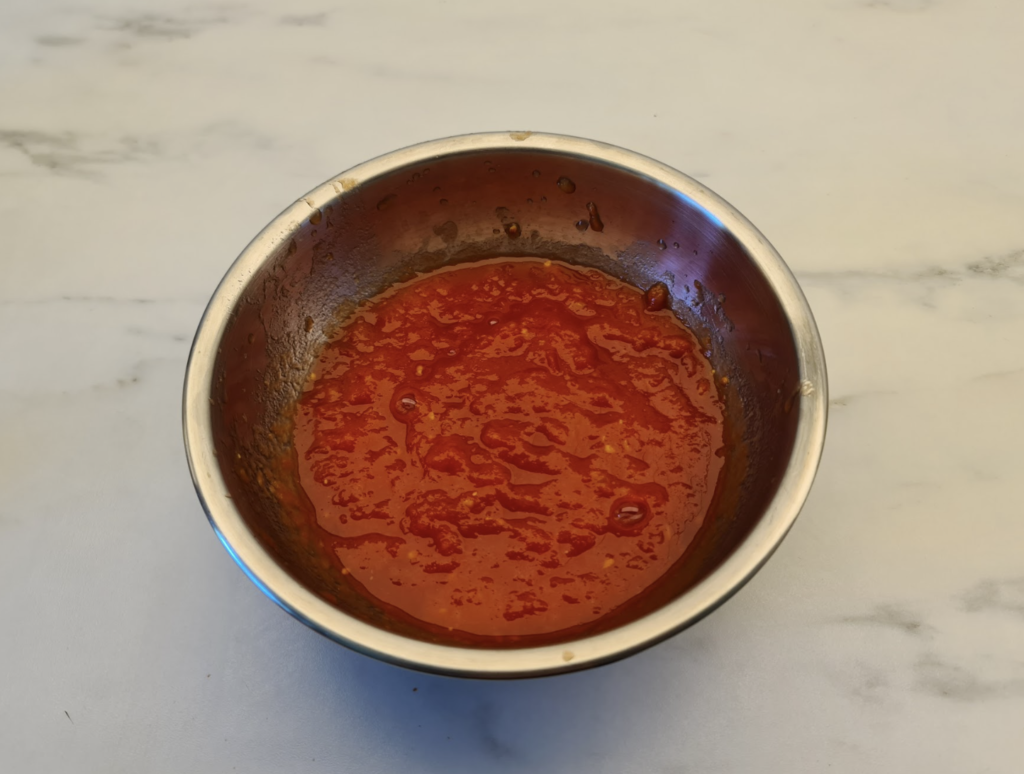
Depending on the type of tomato you use, some cans contain a lot of water. If that’s the case, I recommend draining off the excess liquid using a fine mesh sieve and only using the tomatoes.
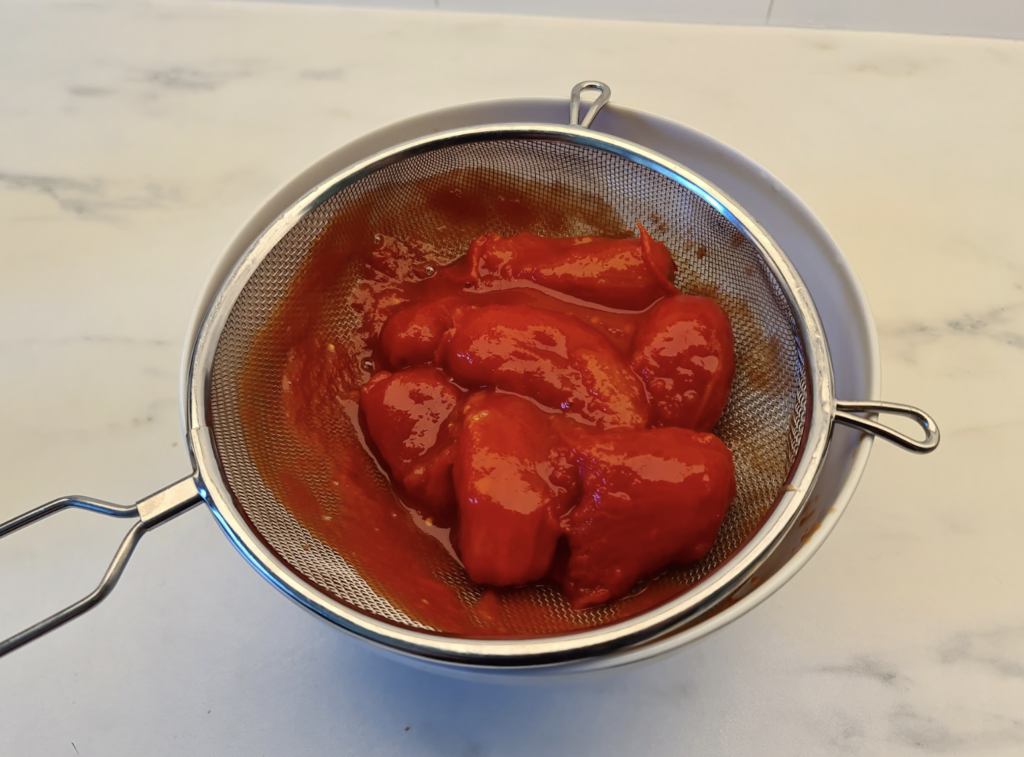
The best tomatoes for Neapolitan pizza sauce
The best choice for Neapolitan pizza sauce is canned, peeled tomatoes.
Canned tomatoes are picked and preserved at their peak. This ensures consistent quality and flavor all year round. Not only do they provide a great taste, but they also make sauce preparation simpler and more convenient.
San Marzano tomatoes are the classic pick for Neapolitan pizza sauce. The reason is their bright, sweet, and balanced flavor.
You can also use fresh tomatoes, but they are typically reserved for the summer months when they are at their best. Fresh tomatoes offer a different flavor profile and are often used in more seasonal recipes.
San Marzano tomatoes – the golden standard
San Marzano tomatoes are often hailed as the gold standard for Neapolitan pizza. What makes San Marzano the ultimate pizza tomato is the distinct flavor profile: sweet and low in acidity. They also have a robust, strong tomato flavor compared to many other types of tomato.
Have you ever compared different types of tomatoes side by side? I have, and let me tell you, the difference between high-quality and subpar tomatoes is striking. It’s an eye-opener to how crucial the right tomato can be to the flavor of your sauce, and your pizza.
San Marzano tomatoes come with a higher price tag, but what you’re paying for is the flavor. Tomatoes are often overlooked, but if you want to make the best possible pizza, you also need the best tomatoes you can find.
Sourcing San Marzano tomatoes
Finding authentic San Marzano tomatoes can be a challenge, but it’s well worth the effort for the superior flavor they bring to your pizza sauce.
Where to buy San Marzano tomatoes
You can find them at specialty Italian grocery stores, gourmet food shops, or larger supermarkets with an extensive international section. If you don’t have any specialty stores or large supermarkets nearby, the easiest place to get San Marzano tomatoes is online.
Look for the DOP marking to ensure you get the real deal
When purchasing San Marzano tomatoes, look for the DOP (Denominazione di Origine Protetta) marking. This certification ensures that the tomatoes are grown and processed in the specific region of San Marzano, Italy, adhering to strict quality standards. While other tomatoes also can make a good sauce, if you’re paying a premium for San Marzano, you’ll want to ensure you’re getting the real deal.
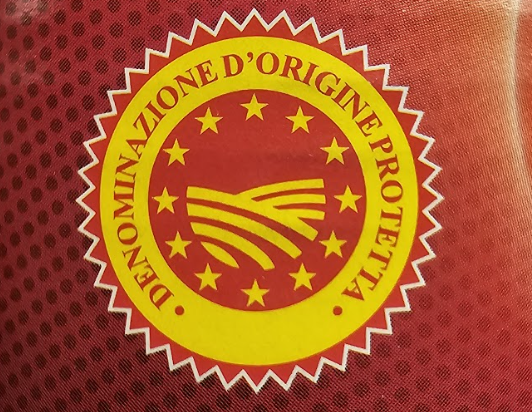
There are numerous brands of San Marzano tomatoes. So, specific brand recommendations can be tricky, as availability varies based on location, and the flavor profile might change from year to year depending on the harvest. As long as you find the DOP label on a can of San Marzano tomatoes, you can be certain they will be good.
My go-to tomato brand is Strianese. They are reliable, good-tasting, and reasonably priced at my local Italian market. Other great brands are Cento, Mutti, and La Valle – all of these brands will make outstanding Neapolitan pizza sauce.
A chef I spoke with shared an interesting insight: many top pizzerias in Naples switch their tomato suppliers annually to ensure they always use the best, most flavorful tomatoes each season. This practice highlights the importance of not just the type of tomato, but also the quality of the specific batch.
The importance of hand-crushing the tomatoes
One of the most common mistakes when making Neapolitan pizza sauce is blending the tomatoes. This will not only give you the wrong consistency but also ruin the flavor of your outstanding tomatoes.
I’ve made this mistake myself, taking the shortcut of blending the tomatoes, only to find that they didn’t taste as sweet as they should… (And yes, I took another shortcut of adding sugar to compensate), wondering why I paid so much for these San Marzano tomatoes.
When blending the tomatoes, you’ll crush the seeds. This is a problem because the seeds contain bitter compounds that will be released into your sauce, ruining the sweet and low acidic flavor of the good tomatoes. You should always hand-crush your San Marzano tomatoes to keep the seeds intact. Hand-crushing preserves the natural taste and texture of the tomatoes, which is essential for Neapolitan pizza.
The extra effort to hand-crush your tomatoes makes a big difference in the taste and texture of your pizza sauce!
Alternative tomatoes
When making Neapolitan pizza sauce, the quality of the tomatoes is paramount. While San Marzano tomatoes are renowned for their exceptional flavor, traditional Neapolitan pizza-making also values other varieties.
Other AVPN-approved tomatoes
In addition to San Marzano, the Associazione Verace Pizza Napoletana (AVPN) recognizes:
- Corbarino (Pomodorini di Corbara)
- Piennolo (Pomodorino del Piennolo del Vesuvio D.O.P.)
Both are excellent tomatoes, but unfortunately, they are hard to find outside of Italy.
What if I can’t find San Marzano tomatoes?
A more easily accessible alternative to San Marzano tomatoes is Roma tomatoes.
During my last visit to Naples, I had a chat with a seasoned Pizzaiolo about sauce. He recommended Roma tomatoes as an excellent substitute for San Marzano. Known for their robust flavor and firm flesh, they can serve as a great option when other varieties are unavailable.
While San Marzano tomatoes are considered the gold standard of Neapolitan pizza, don’t hesitate to explore other alternatives. The key to great sauce is to use the best quality tomatoes you can find to ensure your pizza sauce is as flavorful as possible.
Neapolitan pizza sauce from fresh tomatoes
Even though you can find fresh tomatoes in the grocery store year-round, fresh tomatoes can be really special. You should only make pizza sauce from fresh tomatoes when tomatoes are in season. San Marzano tomatoes are at their best between July and September.
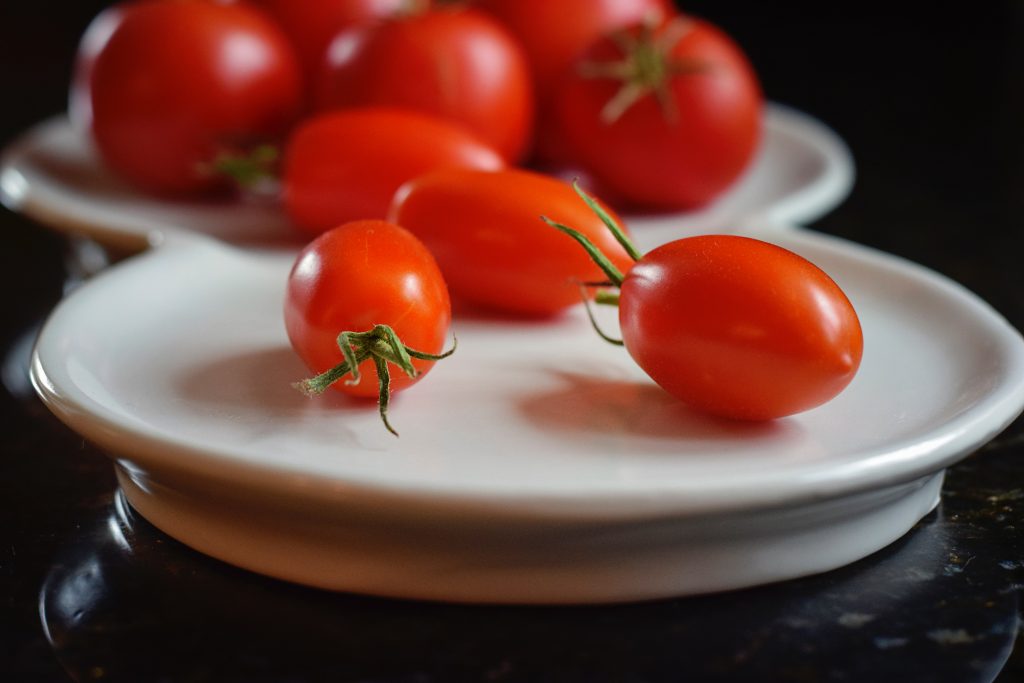
The traditional way to make pizza sauce using fresh tomatoes is using a wide-mesh food mill to mill the tomatoes. This is done to grind the fruit, pulp, and peel off the tomatoes.
Cuisipro Deluxe Food Mill features three interchangeable disks for perfect texture. Its large 18/10 stainless steel bowl and unique underside scraper make processing tomatoes for Neapolitan pizza sauce a breeze. Easy to use and efficient.
Start by cutting off the stems, and dice the tomatoes. Next, mill them in the vegetable mill, and add a few basil leaves, salt, and extra virgin olive oil. For exact measurements check the instructions in the recipe below.
It is however hard to get fresh San Marzano tomatoes outside of Italy. You can use other types of sweet tomatoes for your pizza sauce, but your best bet is canned San Marzano tomatoes.
How much Neapolitan sauce you’ll need
Figuring out the right amount of sauce to prepare can be tricky. You don’t want to run out during your pizza-making session, but you also don’t want excessive leftovers.
For most Neapolitan pizzas with tomato sauce, you’ll need about 70-100g (approximately 2.5-3.5 oz) of sauce for a 12-inch (30cm) pizza. This means a 400g (14 oz) can of tomatoes is enough for 4-5 pizzas, while an 800g (28 oz) can is enough for 8-10 pizzas.
| Grams | Ounces | Number of 12-inch pizzas |
| 400g | 14 oz | 4-5 |
| 800g | 28 oz | 8-10 |
I usually plan with one 400g (14 oz) can for every four pizzas. This typically leaves a little extra, ensuring I won’t run out of sauce mid-session. It’s better to have a bit more than needed than to face the disappointment of guests leaving hungry or sad because there wasn’t enough sauce!
Beyond traditional Neapolitan pizza sauce
Even though the AVPN only allows tomatoes and salt for true Neapolitan pizza sauce, it’s not uncommon in Naples to add other ingredients to the sauce.
The most common additions to the sauce are fresh basil and extra virgin olive oil. Basil adds a fresh, aromatic touch, and the olive oil adds a richer texture and nice aromas.
FAQ about Neapolitan pizza sauce
In this section, I will answer the most frequently asked questions about Neapolitan pizza sauce.
How much sauce do you need for a Neapolitan pizza?
For a 12-inch (30cm) Neapolitan pizza you need 70-100g (2.5-3.5 oz) of tomato sauce.
How many pizzas can you make from a can of tomatoes?
You can make enough sauce for 4-5 pizzas from a 400g (14oz) can of tomatoes, and 8-10 pizzas from an 800g (28 oz) can of tomatoes.
How much salt do you need for Neapolitan pizza sauce?
You should use 1g of salt per 100g of tomatoes for Neapolitan pizza sauce, which is around 1% salt.
Example: For a 400g (14oz) can of tomatoes, you need 4g of salt (approximately 3/4 tsp).
Do you cook Neapolitan pizza sauce?
No, Neapolitan pizza sauce is used raw on the pizza.
Do you need San Marzano tomatoes to make Neapolitan pizza sauce?
No, you don’t need San Marzano tomatoes. Although other types of tomatoes are approved by the AVPN and used in Naples, San Marzano tomatoes are the most accessible traditional option outside of Italy.
You can make great pizza with other tomatoes, but for authentic Neapolitan pizza, the key is to use the best possible tomatoes you can find.
How long does Neapolitan pizza sauce last in the fridge?
Neapolitan pizza sauce can last up to 5 days in the fridge.
Can you freeze Neapolitan pizza sauce?
Yes, you can freeze Neapolitan pizza sauce for up to 3 months.
Related
- Is Your Pizza Dough Too Dry? Here is How to fix it! - June 10, 2024
- The Ultimate Guide to the Pizza Dough Windowpane Test - June 8, 2024
- The Ultimate Guide to Autolyse Pizza Dough - June 7, 2024
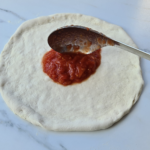







Pingback: How to Use a Pizza Steel: Perfect Pizza Made Easy - The Pizza Heaven
Pingback: The Best Store-Bought Pizza Sauce - The Pizza Heaven
Pingback: Neapolitan Pizza Calories - Will it Make You Fat? - The Pizza Heaven
I like the look of your blog and I’m going to do a similar thing with mine. Do you have the theme or where you get the theme from please?
Hi, thepizzaheaven.com is built witht the Astra theme. Good luck with your blog!
trying to learn the art of pizza making this wonderful blog. so far I’ve had 2 tries and I think in both cases my dough over fermented.
Do you have any videos to help us see where we could be going wrong? or can you consider making some videos or live pizza making with caputo flour?
thanks
Nadine
Hi! I don’t have any videos yet, but they might be coming in the future. But I’m working on improving the images in the recipe to make it easier to see if you’re doing it right. If you have any specific questions or problems, I’d love to try to help you!
Great start if you are looking for a Neapolitan style pizza with an Ooni pizza oven. https://www.youtube.com/watch?v=xqVgJHThsco
Vito Iacapelli has a great home pizza video as well. https://www.youtube.com/watch?v=G-jPoROGHGE
Perfect with pizza Diavola! Thanks
Thank you, turned out perfect with my margherita!
Exactly what I was looking for
Tried San Marzano for the first time and wow it made a difference!